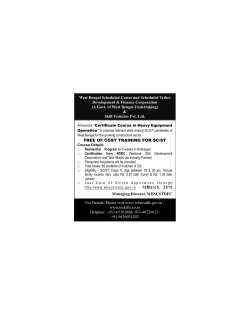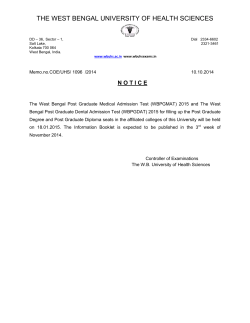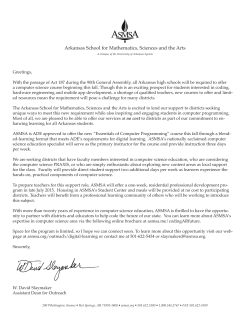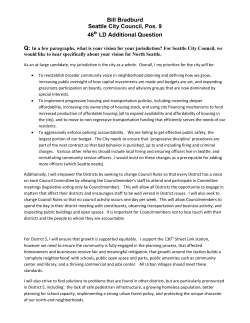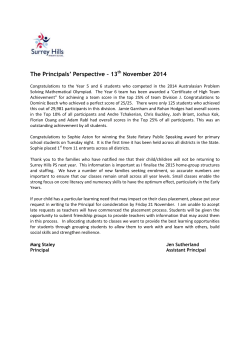
Learning achievement at the elementary level in rural West Bengal
Learning achievement at the elementary level in rural West Bengal Rabindranath Mukhopadhyay Department of Economics, University of Calcutta And Dibakar Chatterjee Department of Economics, University of Calcutta Paper prepared for the CESI 2014 Delhi Conference, scheduled to be held at the Delhi University during November 16th to 18th, 2014. Acknowledgement: This is an abridged and revised version of the report prepared under the summer internship programme, 2014 and submitted to the ASER, New Delhi. This report was prepared by the group of following five students of the M.Sc. (Economics) session 2013-15 of the University of Calcutta: Subhasis Das, Upasana, Sarnali Seal, Debendra Mali and Ankita Singh. Computation as also design and interpretation of the results were made by all the five. However, final draft of the report was prepared by Subhasis. The authors are grateful to all the five students especially to Subhasis. Learning achievement at the elementary level in rural West Bengal ABSTRACT West Bengal has participated in the nation-wide goal of universalisation of elementary education. She proposes a wider access along with quality upliftment of the prevailing system. This paper investigates how far the promise has been kept from the quality perspective. An overview of elementary education in rural West Bengal is provided in this context. This exercise is based on cross-district secondary data from the ASER on ability to read (vernacular) and simple calculation. Simple statistical tools have been used for data analysis. The exercise identifies the high and low performing districts and studies their performance over the years. The trend analysis unveils retrogression of the quality parameter over the years. Policies have all along been stressed on steady expansion in enrollment without paying much attention to the learning outcome. Quality has thus been compromised in the process. INTRODUCTION Education is an act of imparting knowledge & developing the powers of reasoning and judgment of an individual. In today‟s world, it has become quite an important determinant of a person‟s economic or social empowerment. To be successful in the 21st century, we need a system of education that is robust, accessible and equitable. While numbers and quantity will always be a challenge for a country like India, the role that quality plays in any scenario cannot be undermined. The education structure and policies followed by the West Bengal Government are designed to fulfill the nation‟s promise of reaching the Millennium Development Goals for education. The Department of School Education has been set up to deal with educational challenges of expansion, equity, excellence and employability at the primary, secondary and higher secondary level. Universal access, reduction in dropout rates, increase in retention rate, optimal presence of infrastructure (both human and physical) and enhancement of quality come within the purview of their operation. Utkarsha Abhijan is a note-worthy initiative where the students of primary schools will be assessed to get an idea of their learning levels. Through this program they intend to generate awareness regarding the quality of education amongst teachers, guardians, government officials at different levels and the community at large. Infrastructural facilities have improved, dropout rates are negligible at the primary level, and many more teachers have been appointed. More school incentives (such as free textbooks and the serving of cooked meals) have led to better outreach and coverage. According to ASER report 2005, never enrolled is only 1.5% and dropout is 2.9% in the age group 6-14yrs. However, concerns have risen about the quality of education. According to the same report, 22.1% and 48.5% children in age group 7-14 yrs cannot read standard 1 and 2 level vernacular texts. Arithmetic performance is even worse: 51.3% cannot do division. Thus, the quality of learning in our classrooms remains a concern. This project makes an attempt to verify whether the quality aspect has lost ground in the course of delivering education to the masses in rural areas of West Bengal. It begins with the overall learning achievement statistics of West Bengal followed by cross-district analysis. It also provides a section on regression, discusses the factors that affect the learning outcome. Finally, it concludes with the major findings. LITERATURE SURVEY The issue of quality primary education is appropriate not only because India is reaching the goal of universal primary education but also because the Sarva Shiksha Abhiyan (SSA) seeks to provide quality elementary education to all the students enrolled. As of now, learning achievements, when compared with expected notional levels for primary grade students, are quite unsatisfactory as is revealed by the yearly ASER reports. It has been seen that almost half of the students studying in class V cannot read and comprehend a Standard II Text and morethan65% cannot do a simple division (ASER, 2013). However most of the official statistics available today do not provide much information on this aspect. In the existing academic literature, there exists an over-whelming consensus towards the low quality of Indian primary and elementary education. Empirical studies have done in this regard considering different household and school characteristics as responsible for low learning achievement. Studies such as Ahluwaliya (2014), Banerjee &Duflo (2011), Kumar(2010) et al. consider learning achievement at the national level. Studies have also been done in this regard by different scholars for different states. As per DISE 2007 ‐ 08, there has been a 13.5% increase in national Net Enrolment Ratio in primary grade between 2005 ‐ 06 and 2007 ‐ 08: from 84.53% in 2005 ‐ 06 to 95.92%in 2007 ‐ 08. A stable high Net Enrolment Ratio in elementary education will however; largely depend on sustained improvement in survival rate especially in the primary stage (i.e. proportion of pupils starting Grade I who reach the last grade of primary). DISE 2007 ‐ 08 finds out the survival rate at primary level up to Grade V. During 2007 ‐ 08 More than 9% of children enrolled in Grades I to V dropped out from the system before completion of primary grade and there were no major differences in drop ‐ out rate among boys and girls. The corresponding percentage during 2005 ‐ 06 And 2004 ‐ 05 were 9% and 10% respectively. Reports also suggest that basics not being built up at the 1st-2nd grade level are reducing the ability to learn in higher grades Vyas (2014). In 2005, in India, rural private school enrollment was 17%, it rose to 29% in 2013. Ironically, after Indian Parliament declared that it would provide free and compulsory education to all children, the pace of enrollment in private schools quickened Chavan (2013). In a research paper by Jyotsna Jalan (2010),the quality of primary education in West Bengal is looked into in detail. The study considers a total of 7 districts in West Bengal as opposed to the 17 districts considered in the ASER survey. The study confirms that learning levels and attendance rates in primary schools remain low in rural West Bengal. Regarding student‟s performance in reading and arithmetic, the study shows a direct relationship between language and numeracy test scores i.e if a child has performed well in one subject she is also likely to have performed well in the other subject. However, because of the differences in sampling methodology, survey design and test administration, the results of the paper cannot be easily compared with ours. According to reports released by the Pratichi Institute for the state of West Bengal, overall participation in secondary education has increased in recent years though a huge amount of enrolment is wasted during the transition from standard 5 to 6 and from standard 9 to 10, with better proportion of girls participating in such examination. Although 80 percent of secondary students in West Bengal pursue free education against the national average of 48 percent, the expenditure in private tuition in general in West Bengal is very high, that makes the average per capita expenditure in secondary education in the state 44 percent higher than the national average. Another study by French & Kingdon (2008) uses ASER data from 2005-2007 to assess the relative effectiveness of private and government schools in rural India. The study uses standardized values of the student‟s achievement score and does a regression analysis using State, district, village and household fixed effects respectively. The study finds consistent evidence of a private schooling advantage throughout the methodologies. Although the regression analysis is similar to ours, we felt that it wouldn‟t be right to combine the reading and mathematics score as one and thus we have two separate regressions for reading and arithmetic. The discussion of existing literature seems to suggest that the expansion of education in India has been quantity-centric as opposed to the child-centered, holistic and context-based views of education endorsed by the international Education For All (EFA) goals. The present study focuses on the state of West Bengal and seeks to understand the present state of primary and elementary education in the state. We also take recourse to different econometric methods to understand how different variables affect the quality of education. OBJECTIVES The objectives of our study are mainly related with the qualitative dimensions of education and can be enumerated in the following points: To look at the current state along with over the years analysis of quality parameters. To focus on district-wise achievement levels and categorize them into good or bad based on their performance. To single out the districts those are in a dire condition educationally and are in urgent need of intervention. To see the impact of gender, household income, mother‟s education, child‟s class, school type, tuition on learning outcomes. DATA AND ITS LIMITATIONS The data is extracted from Annual Status of Educational Report (ASER), conducted by PRATHAM. The organisation started this survey to look after the educational quality in rural India. The unit of observation is a child. The main strength of the data is that, the number of observation is huge covering a large number of attributes (like, reading, arithmetic, parents’ education, many household and village observations etc). Findings are disseminated at national, states, districts, villages and households level. The report has been conducted since 2005 but in our analysis we use the data for the year 2008-2012 due to commonality of attributes. In 2008, 11318 children of the age group 6-14 were covered in West Bengal. This figure was 9711 in 2009, same in 2010, 9148 in 2011 and 7961 in 2012. This large number of observations is split up into three standards: 1-2, 3-5 and 6-8. Two tests that have been taken into account are reading skill (in vernacular) and arithmetic skill. Both the tests have five categories: in case of reading, these are read nothing, read letter (set of common alphabets), read word (common familiar words with 2 letters and 1 or 2 matras), read paragraph (set of simple 4 linked sentences. Each no more than 4-5 words) and read story (short story with 7-10 sentences). For arithmetic test, these are do nothing, recognize number 1-9, recognize number 1099, do subtraction (2 digit numerical problems with borrowing) and do division (3 digit by 1 digit numerical problems). We use these data in our own way to meet several objectives. To check the standard wise learning outcome, we set different benchmarks to evaluate the ability of a child accordingly to his standard. The reading ability of standard 1-2 students is measured by the fact that whether the child can read at least word, for standard 3-5 students this yardstick is to read at least paragraph and for standard 6-8 students this benchmark is set at story level. In case of arithmetic skill, a standard 1-2 student is measured by the fact that whether the child can at least recognize the number 10-99, for standard 3-5 students this yardstick is to do at least subtraction and for standard 6-8 students this benchmark is set at division level. Mean and standard deviation are utilized for the analysis of data in case of cross-districts analysis. We use two decimals places while analyzing. The database suffers from some limitations. At first, there is no data regarding the school observations. Secondly, the district South 24 Parganas was not surveyed in the year 2012, so we excluded this district from the dataset. Thirdly, 10 percent of the observed children have not been tested in any of the two subjects which decrease the strength of data. In this section, we will look at the scenario prevailing in West Bengal as a whole and also at the district level, in terms of reading and calculating abilities. We want to see, in our pursuit to achieving the MDG, where the elementary schools in rural West Bengal stand today in terms of qualitative performance. CROSSECTION ANALYSIS: Table 2.1: Mean and Standard Deviation of reading and arithmetic performance in West Bengal in 2012 Standards Reading Arithmetic (%) (%) 1-2 41.84 39.12 (15.43) (15.32) 3-5 58.46 42.39 (13.94) (14.14) 6-8 65.90 35.88 (11.07) (11.30) Source: self calculated Table 2.1 presents the 16 district mean1 and standard deviation2 (in parentheses) for reading and arithmetic test performances across the standards for the current year. Utilizing the table for comparison between the tests, we find the mean is higher for reading across the standards. The S.D is approximately same for both the test across standards. Thus on basis of average 1 2 Average percentage of student who can read and do calculation according to the standard‟s benchmarks. Variation in the percentage of students who can read and do calculations at the district level we can conclude that reading test performance is better compared to arithmetic. Analyzing the rows for different standard performances reveals that as we move up the standards the S.D. keeps falling for both tests. The mean for reading improves. The average for arithmetic improves in 3-5 but falls in 6-8. The average and S.D together implies that higher classes produce better results in reading. But in case of arithmetic we cannot come to a similar conclusion. 6-8 has the lowest average among the standards. INTER-TEMPORAL COMPARISON: Figure 2.2.1 is diagrammatic representations of mean and standard deviation respectively for reading test. Both the figures depict a deteriorating outcome in reading. On one hand the average has diminished and on the other the variation has increased in the current year. Standard 3-5 has the highest fall in mean and rise in S.D. Figure 2.2.2 represents mean and standard deviation for arithmetic test. Here also we find a degrading scenario: rise in variation and fall in the average. The gap between base and current year average performance is highest for standard 6-8. In case of S.D. the rise is approximately same for standards 1-2 & 3-5 but in 6-8 there is only marginal increase. Comparing the two test results we find the fall to be more severe in case of arithmetic. Hence it is evident from these figures that learning outcomes in both tests across standards are exhibiting downtrend which is disappointing and alarming. Figure 2.2.1: Reading performance of West Bengal over the years (mean and standard deviation) Source: self calculated Figure 2.2.2: Arithmetic performance of West Bengal over the years (mean and standard deviation) Source: self calculated TREND OVER TIME In the following section, we will be looking at the trends from 2008-2012 for both Reading and Arithmetic in West Bengal. Reading: The Table 2.3.1 in the Appendix, represents the percentage of children who can read nothing, letters, words, paragraphs, and story during each year from 2008-2012 with total number of observations given in the last column. The following figure is the diagrammatic presentation of the table. Figure 2.3.1: Learning ability of the children across different level of reading skill over the year From Figure 2.3.1, we can observe that the percentage of children, who can read a story, is way more than the percentage of children who can read nothing. The proportion of children being able to read a story increases over the year. The percentage of children, who cannot read anything, is decreasing up to 2010 but after that it shows continuous increase till 2012. The percentage of children who can read a letter has overall remained same over the years. The trend line of the proportion of children who can read word shows a fluctuating graph: there is a steep fall in 2009, followed by an increase in 2010 and again starts to decline slightly. The line showing the percentage of children who can read paragraph has declined over the years from 2009. Figure 2.3.2: Learning ability of the children across different level of arithmetic skill over the year Arithmetic: In Table 2.3.2 in Appendix, the proportion of children are categorized on the basis of their mathematics skill in different level: knows nothing, recognize 1-9, recognize 10-99, do subtraction and do division for the years 2008-2012 with the total number of observations in the last column. Figure 2.3.2 is the diagrammatic presentation of the table. From Figure 2.3.2, it is seen that the percentage of children who can do division rises in 2009, establishing an improvement in the calculating level and then declines, showing deterioration over the years. The proportion of children who cannot recognize even a single digit number, is more or less same till 2011 but it shows a slight increase in 2012. The percentage of children who can recognize 1-9, gradually decreases till 2010 but after that it starts to increase. The trend line, showing the percentage of children who can recognize 1099 shows approximately similar trend as the previous category. The percentage of children who can do division is same in 2008-2010 but shows a slight decline in 2011, followed by a steep fall in 2012. APPENDIX: Table 2.3.1: Learning ability of the children across different level of reading skill over the year Year Nothing Letter 2008 9 15 2009 8 16 2010 7 17 2011 9 17 2012 11 16 Source: ASER data 2008-2012 Word Para Story Total percentage 16 14 15 14 14 20 20 18 16 14 40 42 43 45 44 100 100 100 100 100 Total number of observations 10965 8728 8411 8020 6610 Table 2.3.2: Learning ability of the children across different level of mathematics skill over the year Year Nothing 1-9 2008 6 20 2009 5 19 2010 5 18 2011 5 19 2012 7 22 Source: ASER data 2008-2012 10-99 Subtraction Division 24 21 22 25 31 25 24 25 24 20 26 31 30 27 21 Total percentage 100 100 100 100 100 Total number of observations 10955 8652 8330 7977 6586 ANALYSIS ACROSS DISTRICTS In the previous section, overall scenario of West Bengal has been analyzed. In this section, results of disaggregate analysis has been reported. Sixteen districts of West Bengal have been considered: Bankura, Bardhaman, Birbhum, Dakshin Dinajpur, Darjeeling, Howrah, Hooghly, Jalpaiguri, Koch Bihar, Maldah, Medinapur, Murshidabad, Nadia, North 24 parganas, Puruliya and Uttar Dinajpur. Kolkata is excluded as it is an urban district. East and West Medinapur are taking together as Medinapur. South 24 Parganas is absent in the ASER data for the year 2012, so it has been dropped from present analysis. Table 2.4.1 shows the distribution of the districts in 2008 and 2012 across the levels of learning. This table gives us the percentage of children in each district, who clear the reading and mathematical tests in each year and each standard. In the last row the average performance for each test, standard and year is shown. Table 2.4.1: Distribution of the districts of West Bengal in 2008 and 2012 across the levels of learning Name of Districts Standard Year Bankura Bardhaman Birbhum Dakshin Dinajpur Darjeeling Howrah Hooghly Jalpaiguri Koch Bihar Maldah Medinapur Murshidabad Nadia N24 Parganas Puruliya Uttar Dinajpur 1--2 2008 2012 65.19 83.21 33.62 24.14 45.60 24.09 27.96 15.00 40.17 37.89 39.51 35.16 38.03 42.98 46.20 39.08 62.11 48.91 49.38 48.65 66.41 54.46 57.52 48.86 41.04 45.57 31.06 32.54 54.19 47.71 50.00 41.18 Reading 3--5 2008 2012 73.31 90.71 59.88 35.47 67.00 46.89 51.11 39.51 65.57 60.00 60.29 39.13 58.54 60.00 58.37 57.34 80.91 66.67 62.55 54.96 68.60 70.59 68.81 66.44 64.02 53.21 53.57 62.99 82.61 69.66 75.91 61.82 6--8 2008 2012 79.55 83.72 65.25 48.32 78.41 54.49 56.78 45.07 71.96 61.90 72.37 64.33 67.61 65.52 67.13 63.38 75.44 68.38 73.76 57.55 82.72 81.50 71.36 65.32 66.14 69.11 63.16 73.17 79.37 79.86 78.82 72.73 1--2 2008 2012 68.33 86.92 27.90 27.35 40.21 22.63 22.58 26.70 41.23 41.05 35.80 38.28 32.38 42.15 30.38 42.35 50.00 35.87 35.19 29.73 45.31 37.00 50.44 40.91 39.55 32.05 29.06 27.20 50.99 57.80 44.15 37.96 Mathematics 3--5 2008 2012 64.29 80.66 48.61 23.03 52.19 26.70 33.09 24.53 60.66 38.76 49.00 29.19 47.77 50.70 44.34 42.96 69.71 35.19 48.00 40.46 52.33 51.72 55.96 44.97 53.05 40.38 54.46 46.45 75.11 53.47 55.91 49.09 6--8 2008 2012 63.64 60.94 37.71 21.77 54.63 23.08 37.19 24.82 54.93 27.21 54.47 33.12 56.45 51.45 37.76 31.34 63.60 33.05 44.06 28.06 41.98 48.54 56.34 33.87 53.44 49.59 54.90 36.59 68.78 39.57 66.50 31.15 Average 46.75 41.84 65.69 58.46 71.86 65.90 40.22 39.12 54.03 42.39 52.90 35.88 Source: self calculated from ASER data, 2008 & 2012 The table shows that most of the districts have deteriorated over the year in their learning outcome. Comparing across standards, 6-8 has deteriorated at the highest amount, followed by 3-5. If performances are compared across subjects, it‟s found that mathematical skill is in more dismal position as compared to reading ability. The districts Bardhaman, Birbhum, Darjeeling, Koch Bihar, Maldah, Murshidabad and Uttar Dinjpur are showing a decreasing trend over the years in both subjects and all standards. In contrast, only one district, Bankura, is showing a good pattern of learning as it has improved its position in every standard and subject over the years. Hooghly district has shown improvement for the standards 1-2 and 3-5 in both subjects but not for the standard 6-8. The districts Dakshin Dinajpur, Howrah, Jalpaiguri, Medinapur, Nadia, North 24 Parganas and Puruliya have improved in one or two categories. Three approaches are utilized for the district wise analysis. In every approach, districts have been classified into two groups: High Performing Districts (HPD) and Low Performing Districts (LPD). Districts with learning levels higher than the 16 districts average (shown in the last row of the table 2.4.1) are considered as the HPD and the ones with lower level are classified as LPD. Three approaches are discussed below. Approach 1: In this approach, for both years, for both subjects and for all standards, districts have been divided into two groups: Consistently High Performing Districts (CHPD) and Consistently Low Performing Districts (CLPD). Performance of a district is identified „High‟ and „Low‟ when found above and below respectively, to learning average over districts for respective years. Table 2.4.2 presents such results for these two groups. Table 2.4.2: Distribution of High and Low Performing Districts across the level of learning over the years (approach 1) Subjects Reading Standard 1-2 3-5 6-8 Year 2008 2012 2008 2012 2008 2012 CHPD average 59.69 65.46 77.96 80.18 79.46 81.79 Bankura 65.19 83.21 73.31 90.71 79.55 83.72 Puruliya 54.19 47.71 82.61 69.66 79.37 79.86 CLPD average 30.79 19.57 55.49 37.49 61.02 46.70 Bardhaman 33.62 24.14 59.88 35.47 65.25 48.32 Dakshin Dinajpur 27.96 15.00 51.11 39.51 56.78 45.07 Source: self calculated from ASER data, 2008 & 2012 1-2 2008 2012 59.66 72.36 68.33 86.92 50.99 57.80 25.24 27.03 27.90 27.35 22.58 26.70 Mathematics 3-5 2008 2012 69.70 67.07 64.29 80.66 75.11 53.47 40.85 23.78 48.61 23.03 33.09 24.53 6-8 2008 2012 66.21 50.25 63.64 60.94 68.78 39.57 37.45 23.30 37.71 21.77 37.19 24.82 Both CHPD and CLPD have two districts each. Average performances of these two groups have been calculated for determining performance gap between the two groups over the years. Performance gap, for any year, is the difference between the average performances of the two groups CHPD and CLPD. Movement of this gap over the period will demonstrate convergence or divergence between the two groups. Box 2.4.1 reports such results. Box 2.4.1: Inter temporal Differences in the performances between group of High and Low Performing Districts of West Bengal (approach 1) Subjects Reading Mathematics Standard 1-2 3-5 6-8 1-2 3-5 6-8 Year 2008 2012 2008 2012 2008 2012 2008 2012 2008 2012 2008 2012 Performance Gap 28.90 45.89 22.46 42.70 18.44 35.09 34.42 45.33 28.85 43.29 28.76 26.96 Source: self calculated from ASER data, 2008 & 2012 Consistent increase in performance gap is observed over the years in every standard and in both subjects, except for mathematics of standard 6-8. Thus two groups are found to be diverging over the period. Mode of this divergence gets determined when inter-temporal changes in average performances of these two groups are compared, separately for each standard and for each subject. The results are presented in the table 2.4.3. Table 2.4.3: Inter temporal changes in the performances separately by the group of High and Low Performing Districts of West Bengal (approach 1) Subject Reading Mathematics Standard 1-2 3-5 6-8 1-2 3-5 6-8 CHPD average 5.77 2.22 2.33 12.70 -2.63 -15.96 CLPD average -11.22 -18.01 -14.32 1.79 -17.07 -14.15 Source: self calculated from ASER data, 2008 & 2012 In case of reading, for all three standards, over the years, performance of CHPD group has improved, whereas that of CLPD group has deteriorated drastically. In mathematics, for standard 1-2, both groups have improved their performances but it is more severe for CHPD than for CLPD. However, in standard 3-5 and 6-8, both groups have shown a decreasing trend in performance. In case of standard 3-5, the extent of fall in average of CLPD is much higher than that of CHPD. But in the next standard, performances for both the groups have deteriorated sharply.. Approach 2. Except the selection of benchmark, approaches 1 and 2 are almost identical. Instead of using year specific averages, here subject specific averages of 2008 have been used as respective benchmarks for both years. As the performance of the overall State has deteriorated over the year, so in this approach, obviously, the number of CHPD will decrease and that of CLPD will increase. The distribution of districts along with their learning performances, separately for these two groups is given in the table 2.4.4. Table 2.4.4: Distribution of High and Low Performing Districts across the level of learning over the years (approach 2) Subjects Standard Year CHPD average Bankura CLPD average Bardhaman Dakshin Dinajpur 2008 65.19 65.19 34.21 33.62 27.96 Nadia 41.04 2012 83.21 83.21 28.24 24.14 15.00 Reading 3-5 2008 2012 73.31 90.71 73.31 90.71 58.34 42.73 59.88 35.47 51.11 39.51 2008 79.55 79.55 62.73 65.25 56.78 2012 83.72 83.72 54.17 48.32 45.07 2008 68.33 68.33 30.01 27.90 22.58 45.57 64.02 66.14 69.11 39.55 1-2 53.21 6-8 2012 86.92 86.92 28.70 27.35 26.70 Mathematics 3-5 2008 2012 64.29 80.66 64.29 80.66 44.91 29.32 48.61 23.03 33.09 24.53 6-8 2008 2012 63.64 60.94 63.64 60.94 42.78 32.06 37.71 21.77 37.19 24.82 32.05 53.05 53.44 1-2 40.38 Source: self calculated from ASER data, 2008 & 2012 This time groups CHPD and CLPD have one and three districts respectively. Following procedure of approach1, group specific values of average performances separately for two groups have been calculated. From these values, performance gaps between the two groups 49.59 for both the years, for both subjects and for all the three standards have been computed. These results have been reported in Box 2.4.2. Box 2.4.2: Inter temporal Differences in the performances between group of High and Low Performing Districts of West Bengal (approach 2) Subjects Reading Mathematics Standard 1-2 3-5 6-8 1-2 3-5 6-8 Year 2008 2012 2008 2012 2008 2012 2008 2012 2008 2012 2008 2012 Performance Gap 30.99 54.97 14.97 47.98 16.82 29.55 38.32 58.22 19.37 51.35 20.86 28.88 Source: self calculated from ASER data, 2008 & 2012 It is observed that, the performance gap has increased over the years in every standards and subjects. Thus the two groups are diverging over the period. Finally, mode of divergence gets determined by comparing inter-temporal changes of average performances of these two groups, separately for both subjects and for each standard. The results are presented in the table 2.4.5. Table 2.4.5: Inter temporal changes in the performances separately by the group of High and Low Performing Districts of West Bengal (approach 2) Subject Reading Mathematics Standard 1-2 3-5 6-8 1--2 3-5 6-8 CHPD average 18.01 17.40 4.18 18.59 16.38 -2.70 CLPD average -5.97 -15.61 -8.56 -1.31 -15.60 -10.72 Source: self calculated from ASER data, 2008 & 2012 Districts belonging to group CHPD have consistently improved their performances over years in both the subjects and for all three standards, barring mathematics of highest standard. On the other hand, for both the subjects across all the standards, there are deteriorations over time in the performance of districts belonging to the group CLPD. Both the approaches demonstrate uniform result: Highest deterioration in inter-temporal performance is observed in case of standard 3-5 for both the subjects (with minor exception in mathematics in former approach). Further, between these two approaches, there is a broad similarity in inter-temporal divergence pattern of performance. Both these results demonstrate precarious situation in the recent past and calls for immediate attention. Approach 3: Here also inter-temporal comparison of the performance gap has been made. Again as usual, performance gap has been computed from the group specific average over districts, separately for two time points. There are two groups: High Performing Districts (HPD) and Low Performing Districts (LPD). Former incorporates those districts whose performances are above state average; others are incorporated in the latter. This procedure is followed for both the subjects across all the tiers and for both the time points. Following the pattern of exposition of the previous two approaches, results of such calculations are reported in following tables: Table 2.4.6; Box 2.4.3; and Table 2.4.7. Table 2.4.6: Distribution of High and Low Performing Districts across the level of learning over the years (approach 3) Subjects Standard Year HPD average 2008 57.83 LPD average 38.13 2012 53.28 Reading 3—5 2008 2012 73.88 67.54 6—8 2008 2012 76.93 69.38 32.94 59.32 65.35 1--2 51.40 61.41 1—2 2008 2012 50.07 48.22 Mathematics 3--5 2008 2012 62.30 49.80 6—8 2008 2012 58.88 38.15 32.56 47.60 39.74 32.05 36.63 30.91 Frequency of HPD 7 7 9 7 7 11 Frequency of LPD 9 9 7 9 9 5 Source: self calculated from ASER data, 2008 & 2012 Box 2.4.3: Inter temporal Differences in the performances between group of High and Low Performing Districts of West Bengal (approach 3) Subjects Reading Standard 1-2 3-5 6-8 Year 2008 2012 2008 2012 2008 2012 Performance Gap 19.70 20.34 14.56 16.14 11.58 7.97 Source: self calculated from ASER data, 2008 & 2012 Mathematics 1-2 3-5 6-8 2008 2012 2008 2012 2008 2012 17.50 16.17 14.70 13.17 19.14 7.24 Table 2.4.7: Inter temporal changes in the performances separately by the group of High and Low Performing Districts of West Bengal (approach 3) Subject Reading Mathematics Standard 1-2 3-5 6-8 1-2 3-5 6-8 HPD average -4.55 -6.34 -7.55 -1.85 -12.50 -20.73 LPD average -5.19 -7.92 -3.94 -0.51 -10.97 -8.83 Source: self calculated from ASER data, 2008 & 2012 Unlike previous two approaches, it is a case of mixed results of improvement and deterioration in the behavior of performance gaps between two said time points. However, inter-temporal changes of group averages for both the groups are found to be uniformly negative in the present case. These two results jointly imply that there is a comprehensive deterioration over time in learning achievements across districts of West Bengal in both the subjects across all the three tiers. For a better understanding of such a result, a diagrammatic representation has been reported in Figure 1.3. Both high and low performing districts exhibit a decline in their performances as shown by the green-red arrows. The fall in high and low performing districts‟ performance over the years is termed as “ac” and “bd” respectively. It is observed that ac>bd. Thus convergence between the high and low performing districts in the present case indicates a red signal in over time performance in level of learning, uniformly across all districts of West Bengal. Figure 2.4.1: Mode of convergence Merits of approach 3 over other two approaches are: (1) it is comprehensive in the sense that it takes care of behaviours of all the districts together; and (2) result is unequivocal in its nature, or in other way, uniform across all districts. It is thus the most strong result obtained so far. Further, combining results of all the three approaches together, it is absolutely an undisputed result that there is continuous deterioration in the level of learning of the students of elementary education during the four-year period from 2008 to 2012. It is thus not only the low performing districts but also the high performing districts that call for immediate attention. A comprehensive as also comparative set of results across all the approaches has been reported in Table 2.4.8. Table 2.4.8: Composite table of inter-temporal change in the performances of the districts by 3 approaches, by groups, by tests. BASIS OF DIFFERENCE Base Year APPROACH 1 Position are based on respected year’s district average APPROACH 2 Position are set by 2008 district average as bench mark APPROACH 3 High and low performing districts categorisation only in 2008 taking 2008 district average separately for each standard and subject and then see the improvement of the same group in 2012 Parameter of being high performing districts (HPD) and low performing districts (LPD) Frequency of HPD & LPD Consistently high and low performing districts in all standards, both subjects and both years HPD-2(Bankura, Puruliya) LPD-2(Bardhaman, Dakshin Dinajpur) Same as approach 1 High performing districts in 2008 in reading and arithmetic separately. Same for low performing districts also HPD-1(Bankura) LPD-3(Bardhaman, Dakshin Dinajpur, Nadia) 1-2 5.77 -11.22 1-2 18.01 -5.97 Standard Percentage change in HPD Percentage change in LPD 3-5 2.22 -18.01 6-8 2.33 -14.32 READING 3-5 17.40 -15.61 6-8 4.18 -8.56 Subject Standard HPD LPD 1-2 -4.55 -5.19 Reading 1-2 7 9 3-5 7 9 3-5 -6.34 -7.92 Mathematics 6-8 9 7 1-2 7 9 3-5 7 9 6-8 -7.55 -3.94 6-8 11 5 MATHEMATICS Standard 1-2 3-5 6-8 1-2 3-5 6-8 Percentage change in HPD 12.70 -2.63 -15.96 18.59 16.38 -2.70 Percentage change in LPD 1.79 -17.07 -14.15 -1.31 -15.60 -10.72 Source: self calculated from ASER data, 2008 and 2012 1-2 -1.85 -0.51 3-5 -12.50 -10.97 CONCLUSION The paper has made an enquiry on whether West Bengal‟s educational achievement exhibits a balance between the quantitative and qualitative dimensions. The learning outcome in the current year shows a better performance in reading compared to arithmetic test. The reading ability improves as one moves up the standards but in case of arithmetic no such uniform result is obtained. Such results indicate children are weaker in arithmetic than reading across the standards. The trend analysis uncovers that the test performances have been declining for both the standards. The rate of fall picks up the pace after 2010 which may be caused by the abolition of pass-fail mechanism in the elementary level. In across district analysis, deterioration of most of the districts over the years is witnessed. This fall in performance is highest in case of arithmetic in standard 6-8. The outcome is most disappointing in standard 3-5. The most comprehensive result obtained shows that there is steady decline in learning levels, especially during last two years. Most interesting result: learning levels of both good performing and bad performing groups have deteriorated and the fall of performance of the good behaving group is greater than that of bad behaving group. West Bengal government has adopted several policies, programs and enacted laws in accordance with its commitment to provide universal elementary education. It is visible from the results that the policies fostered the growth in enrolment but did not fare well in quality front. Policies endeavoring to plug in the quality loopholes should be undertaken. West Bengal has a long path to traverse before achieving a comprehensive diffusion of education among the mass, leading to upliftment of the overall literacy scenario of the nation. 6-8 -20.73 -8.83 References: Ahluwalia, Montek Singh(2014), “Learning outcome in rural schools remain poor: Survey”, The Economic Times, Jan 15. Banerjee, Abhijit V. and Dulfo, Esther (2011), “Top of the class”, Poor Economics, 3rd Edition, Random House India, pp. Chavan, Madhav (2013), “Old Challenges for new generations”, Annual Status Of EducationReport (ASER), 2013, p.1 Chatterji,Madhabi (2014),“Education for All in West Bengal, India: Towards ContextRelevant Quality Indicators and Evaluation Policies for Primary Schools”, Calcutta University Journal (2014) District Information System for Education (DISE), Reports and Statistics (2005-2013) Kumar, Shiva A. K and Rustagi, Preet (2010), “Elementary Education in India: Progress, Setbacks, and Challenges”, Oxfam India Jalan, Jyotsna (2010), “Low Mean & High Variance: Quality of Primary Education in Rural West Bengal”, Centre For Studiesin Social Sciences, Calcutta (2010) Pratichi Institute (2013), “Secondary Education in West Bengal: Prospects and Challenges”, in association with UNICEF, Kolkata Vyas, Ankit (2014),”Low learning outcomes in primary schools in India”, The Indian Economist , Jan 2 ( available at http://theindianeconomist.com/low-learning-outcomes-inprimary-schools-in-india/)
© Copyright 2025
